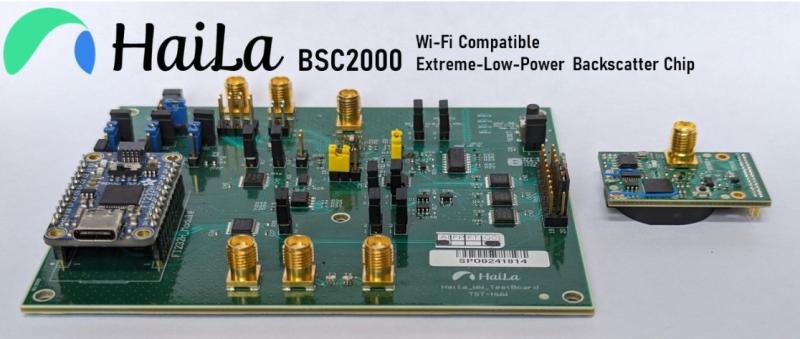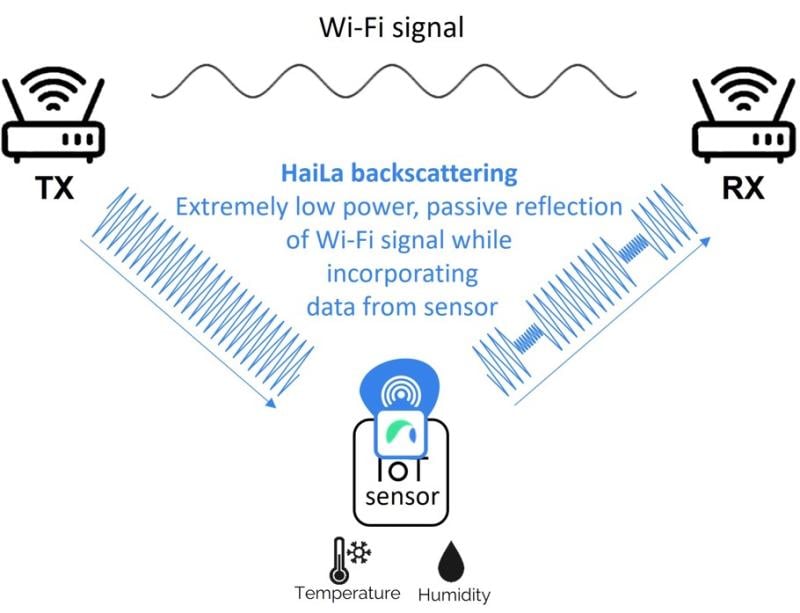Amid the throngs at CES2024 were tech vendors large and small, but none, arguably, as fascinating as HaiLa Technologies based in Montreal.
The company ran a small booth inside the large Murata booth in Hall D, next to exhibits by major carmakers and other manufacturers—all in need of low power-consuming components to help run future cars and other devices.
HaiLa deserves to be called “fascinating” because of how its technology focuses on power-efficient wireless SoCs for IoT devices, but also for its young founder, Charlotte Savage. She launched the company in 2019, picking a name as a tribute to Hedy Lamarr—yes, the actress who was also the inventor of frequency hopping still in use today. She left engineering school at Concordia University in her final year to start HaiLa and snagged a $400,000 convertible note from Canadian VC TandemLaunch, which quickly grew to a $3.7 million funding round.
Then, she won a Nokia Innovation prize worth $150,000 and got government grants of $2.4 million and $340,000. At last year’s CES2023, she and her team met Murata, which led to the partnership booth this time around. Another round raised $10.35 million, including an investment from several investors, including Murata and also Stanford University, which holds three patents that HaiLa has an exclusive license to use. In total, the company has raised $16.8 million.
The decision to leave school for the startup seemed just right, she told Fierce on the show floor. “I was seeing and hearing about this technology, backscatter, and it seemed logical to go with it.” Since then, she hasn’t had many free days or weekends—the typical fate of startup founders. She’s attended CES every year since founding the company and has seen “incredible traction” each time.
This time around, she reported, “the Murata booth was packed the whole show and we had interest from folks wanting to integrate our solution into medical implantables, wearables, remote controls, smart city and smart building sensors, industrial sensors—all the way to autonomous agriculture vehicles. It was such a blast!”
HaiLa CEO Derek Kuhn, who also worked the CES booth, joined HaiLa more than two years ago after a 20-year career in tech internationally, including at IoT-focused Acerta. HaiLa currently employs 15 people full-time, with additional contractors to bring it to 25. Like many CEOs in tech, he said it is hard to find the right talent, but adds, “We have brought together a great team and continue to grow.” The company continues to seek out pros in low power and RF design but also those who “believe in the sustainability theme HaiLa stands for.”
What HaiLa actually does
While ambient power is well-known concept to many engineers, Kuhn said HaiLa knows it is not universally understood and has worked to explain the idea to investors and potential customers. The term “backscatter” fundamentally means the reflection of waves, particles or signals back to the direction where they originated. HaiLa technology uses those signals to append information (such as a sensor reading) to those reflected radio transmissions, which predominate in today’s world. Passive backscatter is the foundational technology used in UHF RFID, deployed in billions of tags a year, Kuhn noted. (“Passive” means there is not added energy, making the system power efficient.)
A short YouTube video HaiLa produced describes the process as analogous to a person on the shore of a lake directing a beam of light toward an island with another person on the island using a mirror to send back a signal using the reflected beam of light energy. With its technology, a backscatter HaiLa sensor tag reflects radio waves already in the air back to a transmitter/receiver, while inserting additional information in the pathway. HaiLa has focused its IP on adaptations of backscatter to existing radio protocols like Wi-Fi with the advantage that no modifications need to be made to the host radio infrastructure, Kuhn explained.
At CES 2024, HaiLa demonstrated its second-generation Wi-Fi compatible backscatter chip, the BSC2000, attached to a tag of HaiLa’s design. The tag and the HaiLa chip were planted on a small board slightly larger than the coin cell battery used to power it. The tag was connected to an environmental sensor mounted on the board, while HaiLa used software running on laptop to show off the sensor data from the HaiLa tag in real time, with the added ability to configure the sensor reading from 250ms to multiple seconds. “In that configuration, the tag can last for years on a coin cell battery,” Kuhn explained. “HaiLa is working to improve this even further”—to as much as a decade. “We are not aware of a more power-efficient Wi-Fi compatible solution.”

HaiLa has the expertise to eventually apply its technology to multiple radio protocols, such as Bluetooth and licensed spectrum cellular, he added. In addition to the BSC2000 chip, the result of a collaboration with Presto Engineering, HaiLa is producing a BSC3000 SoC for power efficient connectivity of IoT sensors over Wi-Fi to support multiple nodes alongside an embedded RISC-V MCU to support hardware encryption of sensor data. The BSC3000 is in design and not ready for sampling.
Kuhn said there has been “very strong demand” for the first two chip evaluation kits to “show the possibility of the technology,” but pricing has not been revealed. HaiLa’s chip operates in the 40 microwatt range and engineers are heading for single digit microwatts in the third generation. Such levels of power consumption allow room-level coverage with existing Wi-Fi, Kuhn said, and HaiLa advertises it envisions eventually reaching a future where a plethora of IoT devices don’t need batteries. “As for coverage, we will get better than room level,” he added.
“Wi-Fi infrastructure will evolve to naturally provide more power to the tag to backscatter,” he said. Meanwhile, HaiLa is also developing a multi-mode radio which will perform very low power active transmit to address coverage needs.
Kuhn acknowledges there is already a “ton of activity in battery-free wireless devices” and he even compliments innovators working to harvest RF by injecting RF energy into a space. “I respect that approach and we can work with it now like other forms of energy harvesting like solar, thermal gradient and inertial. But would it not be cool to just harvest the RF that is already there to power your system?”
Future technology needs to be very power efficient in places where there is not much RF to harvest, like a home or office. “This is a tough problem to address, but I believe HaiLa will develop a radio than can work at those low-power levels…There is a power loss when you backscatter as you might expect from physics. Minimizing this loss is a focus of the HaiLa team.”

Aside from backscatter, the bigger mission
Aside from HaiLa’s mission to power IoT devices using passive backscatter, there is also a related set of ideals that Savage has embraced from the very beginning--a combination of furthering sustainable products and equality for women in tech.
“I have always been hyper-focused on leaving the planet better than when I arrived and entrepreneurship is very aligned with that mission,” she said via email. “I couldn’t imagine any other job. Both fun and frustration comes out in the rollercoaster ride that is the startup journey-- the rose always has its thorns. The best part of my journey is making possible what some believe to be the impossible, suspending disbelief and innovating solutions that will revolutionize the future.
“Building a product that will change the way wireless sensors communicate to no longer depend on batteries and proprietary protocols isn't just a dream anymore. We are close to having a solution to hit the markets in volume. Bringing together, and working with, a world-class team that believes in this extreme low-power communication mission is without a doubt the best part of my job. There is nothing more that I love than high-fives after conquering challenges together.
“The hardest part of my job has been navigating capital-raising for a novel technology over the last five years through many global unknowns--like the pandemic and economic change. Timing won't always be ideal, but the magic happens when you focus on your mission and keep persisting. I believe that anyone with drive, resilience and a passionate dedication to solving a problem can be an entrepreneur, regardless of gender or background. It may not be the path of least resistance, but I can tell you, it is worth it.”
Where does her inspiration come from? Part of it started when she suffered a career-ending rotator cuff injury in 2011 during the time she was competing as an NCAA division 1 water polo player.
“My sports injury changed my life,” she said. “In my teens my dream was to make it to the Olympics. When I retired from water polo, I really struggled and I felt like I lost my purpose and pondered what was my ‘why.’ I wanted to be more intentional with the next chapter of my life, and build a deeper more connected mission for myself.”
And, there’s more to Charlotte Savage’s vision, including the role of women in tech.
“I truly believe everyone can accomplish anything they put their minds to. I am lucky my mom has been telling me that my whole life. If I can inspire other girls in tech, it’s all worth it.”
RELATED: A path to battery-free IoT sensing